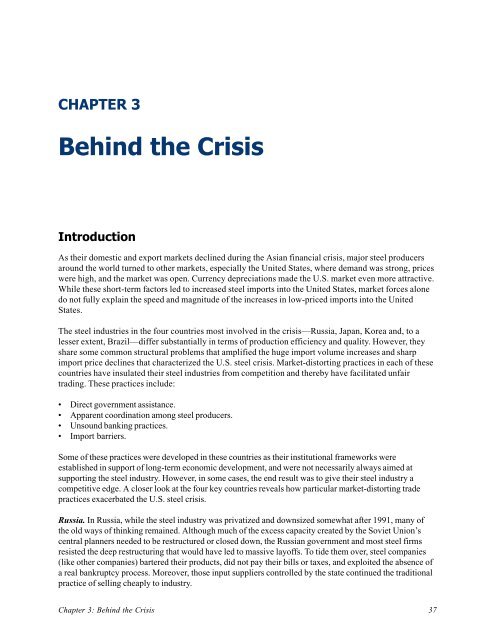Global Steel Trade; Structural Problems and Future Solutions
Global Steel Trade; Structural Problems and Future Solutions
Global Steel Trade; Structural Problems and Future Solutions
Create successful ePaper yourself
Turn your PDF publications into a flip-book with our unique Google optimized e-Paper software.
CHAPTER 3<br />
Behind the Crisis<br />
Introduction<br />
As their domestic <strong>and</strong> export markets declined during the Asian financial crisis, major steel producers<br />
around the world turned to other markets, especially the United States, where dem<strong>and</strong> was strong, prices<br />
were high, <strong>and</strong> the market was open. Currency depreciations made the U.S. market even more attractive.<br />
While these short-term factors led to increased steel imports into the United States, market forces alone<br />
do not fully explain the speed <strong>and</strong> magnitude of the increases in low-priced imports into the United<br />
States.<br />
The steel industries in the four countries most involved in the crisis—Russia, Japan, Korea <strong>and</strong>, to a<br />
lesser extent, Brazil—differ substantially in terms of production efficiency <strong>and</strong> quality. However, they<br />
share some common structural problems that amplified the huge import volume increases <strong>and</strong> sharp<br />
import price declines that characterized the U.S. steel crisis. Market-distorting practices in each of these<br />
countries have insulated their steel industries from competition <strong>and</strong> thereby have facilitated unfair<br />
trading. These practices include:<br />
• Direct government assistance.<br />
• Apparent coordination among steel producers.<br />
• Unsound banking practices.<br />
• Import barriers.<br />
Some of these practices were developed in these countries as their institutional frameworks were<br />
established in support of long-term economic development, <strong>and</strong> were not necessarily always aimed at<br />
supporting the steel industry. However, in some cases, the end result was to give their steel industry a<br />
competitive edge. A closer look at the four key countries reveals how particular market-distorting trade<br />
practices exacerbated the U.S. steel crisis.<br />
Russia. In Russia, while the steel industry was privatized <strong>and</strong> downsized somewhat after 1991, many of<br />
the old ways of thinking remained. Although much of the excess capacity created by the Soviet Union’s<br />
central planners needed to be restructured or closed down, the Russian government <strong>and</strong> most steel firms<br />
resisted the deep restructuring that would have led to massive layoffs. To tide them over, steel companies<br />
(like other companies) bartered their products, did not pay their bills or taxes, <strong>and</strong> exploited the absence of<br />
a real bankruptcy process. Moreover, those input suppliers controlled by the state continued the traditional<br />
practice of selling cheaply to industry.<br />
Chapter 3: Behind the Crisis 37
















